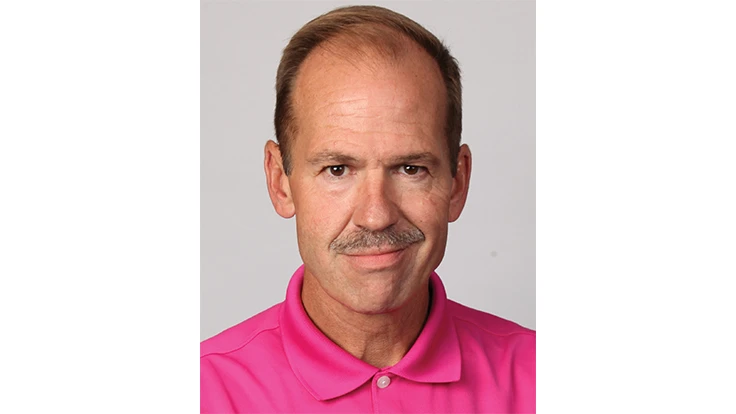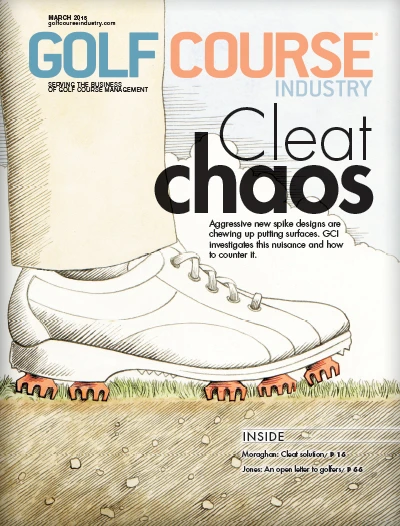
 Pat Jones Pat JonesEditorial Director and Publisher |
Hey! How’s it going? Great day for golf, huh? Nice shirt! Is that an Ashworth? Listen dude, you don’t know me but I’m kind of an old fart who’s been around the turfy side of golf business for a long time. I just need about three minutes of your time to share something your course superintendent really wants you to know but is probably too polite to tell you. If you play regularly, you probably think about your feet a lot. Should they be shoulder-wide or should you go for the super-wide Charles Barkley stance? Should your weight be on the balls of your feet or evenly distributed? Point your left foot out a little or keep it perpendicular? All good questions! But today’s question is about what’s under your feet. Specifically, I’m talking about those thingies on the bottom of your shoes that are designed to improve your traction. Technically, they’re called “cleats” but everyone calls them spikes or soft spikes or whatever. Unless you’re Phil Mickelson, a scratch club rat with an attitude, or a geezer who’s too cheap to replace the FootJoys you bought in 1978, you’ve probably long abandoned metal spikes for these plastic doohickeys. They came into vogue about 20 years ago and, I must say, superintendents and greenkeepers around the world rejoiced! The new soft spikes were vastly superior to old-school nails. We could all walk safely across hard surfaces, wear them anywhere inside and out and the damage to greens was dramatically reduced. If you’re of a certain age, you probably remember the cat-scratches you’d have to endure because the idiot in front of you shuffled around the pin with those dull, half-inch spikes. A lot of those problems disappeared overnight when plastic cleats came along and golf courses – particularly those precious putting surfaces – were way better off for it. Well, the past few years we’ve seen a disturbing trend growing beneath golfers’ feet. Giant, ugly, painful plastic cleats have emerged as a “hot” choice for fancy new golf shoes. I have to admit they look cool on the shelf at Golf Galaxy. They’re almost as big as soccer or football cleats and boy do they dig in. They are, in a word, aggressive. And that’s the problem. They are far too aggressive for most greens. I’m on Twitter a lot and I’ve seen hundreds of pictures like this one of the damage they cause.
Some of the best courses on the planet are already banning these things for good reason. They ruin putting green quality and they spoil the experience for everyone else. So, here’s what your superintendent would tell you if he or she wasn’t so nice: Don’t wear them. If you already have some shoes like this, go back to Dick’s Sporting Goods or wherever and get some lower-profile cleats to switch them out. Get rid of them before you show up someplace cool ready to play golf only to find they won’t let you on their course with these stupid things on your feet. Get rid of them because you want to be considerate to the other folks who have a right to enjoy their round. Get rid of them because they won’t make any measurable difference in how you play. Get rid of them because it’s the right thing to do. Golf is the greatest game of all because of the shared culture of the sport. Part of that culture is being kind to the people who follow behind you. You fix your divots, rake your bunker shots and repair your ballmarks. Those niceties are just another part of the game we all love… but these crazy cleats shouldn’t be. Thanks for listening. Hit ‘em straight!
|

Explore the March 2015 Issue
Check out more from this issue and find your next story to read.
Latest from Golf Course Industry
- ’Twas the Night Before Christmas (on turf)
- Twas the Night Before Christmas (the turf version audio)
- Advanced Turf Solutions and The Aquatrols Company release soil surfactant
- Heritage Golf Group acquires North Carolina courses
- Editor’s notebook: Green Start Academy 2024
- USGA focuses on inclusion, sustainability in 2024
- Greens with Envy 65: Carolina on our mind
- Five Iron Golf expands into Minnesota






